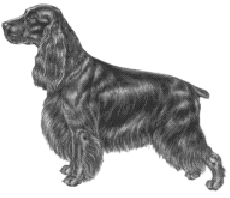Cocker Spaniel
General Information - Cocker Spaniel

Group:
Gundog
Size:
medium
Lifespan:
13-15 years
Exercise:
medium
Grooming:
high
Trainability:
high
Watchdog ability:
high
Protection ability:
low
Area of Origin:
England
Date of Origin:
1800s
Other Names:
English Cocker Spaniel
(United States of America)
Original Function:
flushing and retrieving
game
History
One of the oldest Spaniel Breeds, stemming from the same taproot as all of the modern land Spaniels, the Cocker Spaniel was originally bred to find and flush woodcock and continues to be an equally enthusiastic and capable hunting companion to this day. In addition a successful obedience and agility competitor, show dog and most importantly a loyal family companion.
Temperament
A big hearted little dog whose merry temperament is legendary. This temperament lends itself to a sensible training regime; Cockers respond relatively quickly, they DO NOT, however, respond to harsh training methods. Cockers love long walks, swimming, children, chasing balls, cuddles, rides in the car, good food (don’t over do it) and toys, they dislike teasing, taunting, rough handling, being untidy and unkempt.
Upkeep
The Cocker Spaniels beautiful silky coat with long feathered ears, chest, belly, legs and pants does require regular attention, a regular 6-8 week visit to a professional groomer is recommended. Comb him at least once a week, special care is required around the ear canal keeping this area free from of hair to assist ventilation. Don’t feel you have let the side down if by having your Cocker completely clipped off for summer its much cooler for him and makes swimming much more pleasurable. A Cocker Spaniel requires a moderate amount of exercise although he would probably run all day a “fetch the ball” work out or a walk in the park or on the beach will generally satisfy his requirements.
Cocker Spaniel
A breed standard is the guideline which describes the ideal characteristics, temperament, and appearance of a breed and ensures that the breed is fit for function with soundness essential. Breeders and judges should at all times be careful to avoid obvious conditions and exaggerations, as well as being mindful of features which could be detrimental in any way to the health, welfare or soundness of this breed.
Breed Standard - Cocker Spaniel
 General Appearance:
General Appearance: That of a merry, sturdy, sporting dog. The Cocker Spaniel should be well balanced and compact and should measure about the same from the withers to the ground as from the withers to the root of the tail.
Head and Skull: There should be a good square muzzle with a distinct stop which should be mid-way between the tip of the nose and the occiput. The skull should be well-developed, cleanly chiselled, neither too fine nor too coarse. The cheek bones should not be prominent. The nose should be sufficiently wide to allow for the acute scenting power of this breed.
Eyes: The eyes should be full but not prominent, brown or dark brown in colour but never light, with a general expression of intelligence and gentleness though decidedly wide awake, bright and merry. The rims should be tight.
Ears: Lobular, set on low, on a level with the eyes, with fine leathers which extend to but not beyond the tip of the nose; well clothed with long silky hair which should be straight.
Mouth: Jaws should be strong and teeth should have a scissor bite.
Neck: Neck should be moderate in length, clean in throat, muscular and neatly set in to fine, sloping shoulders.
Forequarters: The shoulders should be sloping and fine, the chest well developed and the brisket deep, neither too wide nor too narrow in front. The legs must be well boned, feathered and straight and should be sufficiently short for concentrated power but not too short to interfere with the tremendous exertions expected from this grand little sporting dog.
Body: Body should be immensely strong and compact for the size and weight of the dog. The ribs should be well sprung behind the shoulder blades, the loin short, wide and strong, with a firm topline gently sloping downwards to the tail from end of loin to set on of tail.
Hindquarters: Hindquarters should be wide, well rounded and very muscular. The legs must be well boned, feathered above the hock with a good bend of stifles and short below the hock allowing for plenty of drive.
Feet: Feet should be firm, thickly padded and catlike.
Tail: Tail should be set on slightly lower than the line of the back; it must be merry, carried in line with the back and never cocked up. The customarily docked tail should not be too long nor too short to interfere with its merry action.
Coat: Flat and silky in texture, never wiry or wavy, with sufficient feather; not too profuse and never curly.
Colour: Various. In self colours no white is allowed except on the chest.
Gait: There should be true through action both fore and aft with great drive covering the ground well.
Weight and Size: The weight should be about 12.7 - 14.5 kg (28 - 32 lb).
The height at the withers should be approximately Dogs 39 - 41 cm (15.5 - 16 in). Bitches: 38 - 39 cm (15 - 15.5 in)
Faults:
- Light bone
- Straight shoulder
- Flat ribs
- Wnsound movement
- Weak hocks
- Weak pasterns
- Open or large feet
- Frown
- Small beady eyes
- Undershot or overshot mouth
- Uncertain or aggressive temperament.
Note: Male animals should have two apparently normal testicles fully descended into the scrotum.
DNZ No 344
Copyright Dogs New Zealand
23 Dec 2013
Any departure from the foregoing points should be considered a fault and the seriousness with which the fault should be regarded should be in exact proportion to its degree and its effect upon the health and welfare of the dog and on the dog’s ability to perform its traditional work.




